Text and photos: Gustasp & Jeroo Irani
We awoke to the tinkle of temple bells. The pundit at the luxe Haveli Hari Ganga hotel in Haridwar was waking the gods that resided in the little shrine located within the hotel premises. We tumbled out of bed, splashed water on our faces and hurried down to partake in the morning aarti. The ceremony had moved to the waterfront by the time we arrived. The pundit swirled a brass lamp with flaming oil wicks over the sacred river Ganga that lapped against the steps of the haveli hotel as it flowed urgently onwards to shower the Gangetic plains with the benediction of its life-giving waters.
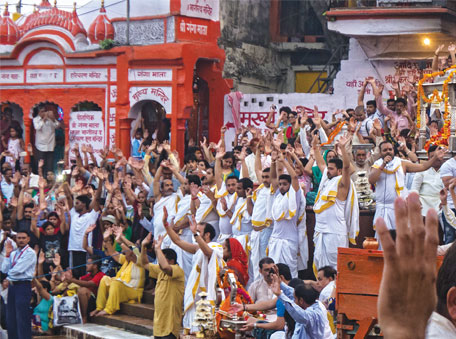
We dipped our feet into the river and splashed our faces with its waters. Other more devout guests gritted their teeth and took a dip in its freezing waters. They emerged shivering from the purifying bath, with their faces glowing with bliss. It was enough to make us shake off our inhibitions, strip down to our shorts and plunge into the ice-cold glacier-fed water. Ma Ganga welcomed us in her all-encompassing embrace, and just to make sure that she did not sweep us away in her surging currents, we held on to the chains placed there for just that purpose. Indeed, there were chains placed on almost all the banks as well as under the archways of bridges, so that pilgrims could hold on to keep their balance, or cling to, should they be swept way in the undercurrent.
Still wet, we climbed up one level of the haveli to the open balcony cantilevered over the river, and looked over its filigreed railing. The waterfront was buzzing with activity: aartis not unlike the one we had participated in, were being performed in all the havelis, temples and shrines that lined the banks of the river: the ringing of bells, swirling of oil lamps, chanting of mantras, call of the conch shells and the splashing of devotees taking a spiritually purifying dip…
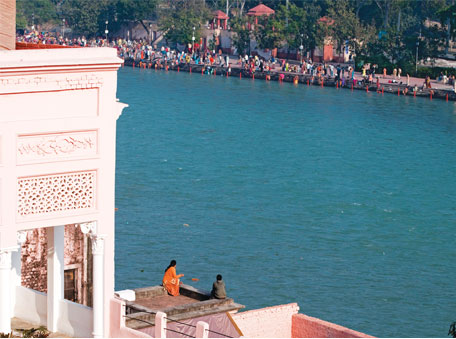
The riverfront promenade below us was alive with colour and endless activity. A sadhu in a wheelchair; a group of weary pilgrims sitting down to share a simple meal; pujaris invoking the blessing of the river on behalf of couples and families; city slickers posing for selfies…The anguished cry of a child drew our attention to a family clustered around a young toddler whose head was being shaved. After the ordeal, the wailing lad was given a good dip in the river, and then rewarded with a bottle of milk on which he sucked contentedly.
Shops and pavement stalls peddled everything that a pilgrim or even a tourist might need: flower boats made of leaves, coconuts, old coins and plastic containers to collect Gangajal, mountains of red kumkum, souvenirs, and fake copies of luxury watches at knock-down prices…Rich aromas of deep-fried savoury snacks, emanating from restaurants and food stalls, filled the air.
Later that morning, we crossed over to the other bank of the river and marvelled at the similarity between this stretch of the waterfront and the canals of Venice: the difference being that instead of opulent mansions and ornate churches, the skyline here was etched with grand havelis and the spires of temples and shrines.
A propitious city
Our awe was in sharp contrast to the sense of despair we felt when we had rolled into the town the previous evening. An unseasonal thunder shower greeted us as we stepped off the train. Since it was the sunset aarti time and most of the roads were closed to motorised vehicles, we huddled into a cycle rickshaw whose flimsy hood offered little protection from the downpour, as it crawled through narrow flooded streets towards our hotel. Indeed, there were sections where it seemed as though the Ganga had spilled over its banks and invaded the town. However, the sight of shopkeepers and local residents carrying on with their everyday lives as though this was perfectly normal, stayed our hand from hitting the panic button.
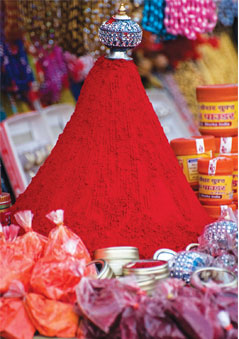
Seeing our concern, our cycle rickshaw driver turned around and reassured us that we were blessed. “Don’t let a little rain upset you. Not everyone has the good fortune of coming to Haridwar. Only a chosen few are blessed with a darshan of the holy city. You may think that you have come to Haridwar, but no, it is Haridwar that has called you to her,” the old man, his face drenched with rain and perspiration, made his grand pronouncement.
His ad-libbed lines may have been well rehearsed but the truth was that they were shared by many who believe that Haridwar holds a very special place in the heart of Goddess Ganga. From all the villages, towns and cities that grace her banks, Haridwar is the one she considered to be her true home. For, it is here that the holy river says farewell to the Himalayas and says hello to the great Gangetic plains of India.
According to local belief, the Himalayas are the home of Ma Ganga’s parents, and it is in the mountains that the sprightly young river frolics through endless valleys. At Haridwar, the river grows up and enters the home of her in-laws. But the identity of the river goddess’s husband remains a mystery. Lord Shiva? No. However, her legend is eternally entwined in his matted locks.
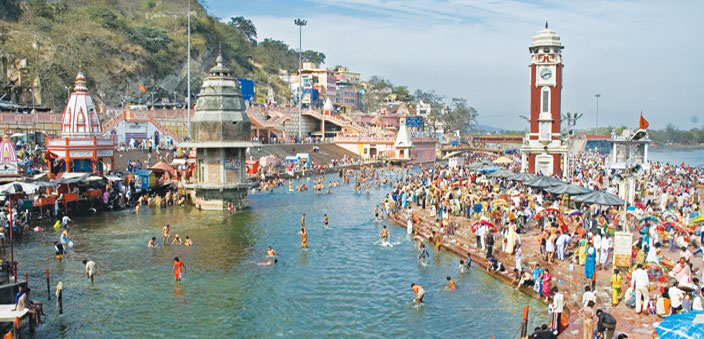
Travelling on the Char Dham circuit of Yamunotri (the source of the Yamuna), Gangotri (the source of the Ganga), Kedarnath (the abode of Lord Shiva) and Badrinath (the abode of Lord Vishnu), we could visualise how this legend panned out in physical terms. Shiva’s locks are manifested in the river’s many tributaries that form confluences at different prayags to eventually become the Ganga; at Devprayag, for instance, the Alaknanda merges with the Bhagirathi to become the Ganga. We stood on a hillock overlooking the sangam: two streams of distinct shades – one clear green-blue and the other murky brown – briefly retaining their identities before merging into each other. At Gangotri, there is a rocky cavern where Lord Shiva is supposed to receive the Ganga in his matted locks. Indeed, Haridwar is the launching pad of this spiritually uplifting and physically demanding Char Dham pilgrim circuit.
And the beloved cosmic tales
Back in cosmic time, Haridwar was also the stage where the tragic love story between Sati and Lord Shiva played out. Sati, the daughter of King Daksha, had married Lord Shiva much against her father’s wishes, as he was revolted by the idea of having a son-in-law who, among other things, smeared his body with the ash of the dead and wore a necklace of skulls. The vengeful king decided to register his protest and humiliate his damaad by performing a sacred yajna or sacrifice to which he invited all the Gods and sages except Lord Shiva. Sati, outraged by her father’s pettiness and obvious attempt to insult her husband, threw herself into the sacrificial fire.

Only Lord Vishnu had the presence of mind to react to this grave predicament. He unsheathed his Sudarshan Chakra or cosmic wheel weapon and hurled it at the lifeless body of Sati and sliced it into 52 pieces (there are different takes on exactly how many pieces there were: some say 72; others 108).This debate aside, Lord Vishnu’s drastic action jarred Lord Shiva out of his stupor. He stopped his devastating dance mid-stride. The universe was saved from total annihilation.
The residue of this tragic love story is still evident across the country as various parts of Sati’s body were scattered across the land, and as they fell, they turned to stone. They are referred to as Shaktipeethas. (One eye fell in Nainital and turned into a lake but that is another story). A happy footnote to the story is that Sati was reincarnated as Goddess Parvati, and the rest is legend.
In Haridwar, however, the Daksha Mahadev Temple on the banks of the Ganga stands on the spot where the traumatic cosmic drama had been enacted. We joined the river of pilgrims who streamed through the complex and stopped briefly at the altar of fire that Sati is said to have leapt into. The memory of her sacrifice still festers like an open wound that just will not heal in the minds of her devotees.
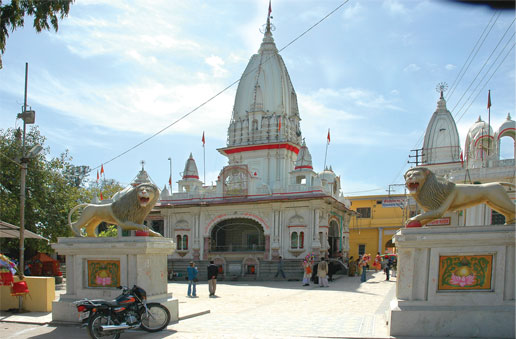
Staying on the pilgrims’ trail, we hopped into a cabin of a ropeway that soared over the forested slopes of Neel Parvat (Blue Mountain), which deposited us at the foot of Chandi Devi temple that rides the crest of a ridge. From up there, we looked down at the grey-blue slash of river Ganga as it coiled out of the surrounding mountains, meandered through Haridwar and eventually eased itself into the great plains of India. Earlier, pilgrims had to trek three kilometres through thick forests (still populated with elephants and other wild animals), to reach the summit.
According to legend, Goddess Parvati took the form of the beautiful maiden Chandi to defeat and oust the demon kings Shumbha and Nishumbha from heaven, after they had captured it briefly from Lord Indra. The existing temple was built in 1929 by the Maharajah of Kashmir, while the main idol of Chandi Devi was installed by the sage Adi Shankaracharya in the 8th century.
Chandi, Mansa and Maya
Chandi Devi is one apex of a trinity of shrines that grant boons to devotees who complete the temple-hopping circuit. The other two are Mansa Devi, perched on the summit of Bilwa Parvat, and Maya Devi at the bathing ghats around Har ki Pauri.

The Maya Devi temple is linked to the sad and dramatic demise of Sati, for it is built on the spot where the heart and navel of the goddess (after Lord Vishnu saved the universe from total annihilation by slicing her charred body with his cosmic chakra), is believed to have fallen. Enshrined in the holy sanctum are the three-headed and four-armed idol of Goddess Maya, one of the many incarnations of Shakti.
We returned to our cosy hotel room at Haveli Hari Ganga with a jumble of legends and myths swirling in our heads. An evening of bhajans at the hotel deepened our sense of the past and the present telescoping into each other, even as the voice of the singer seemed to soar to the heavens along with our prayers and thanksgiving for bringing us to the amazing holy city. We could not help but marvel at the fact that Haridwar juggled time so deftly. Soon we were pumped up and eager to set off for the Ganga aarti, which is the high point of the day for any pilgrim or curious tourist visiting the holy city.
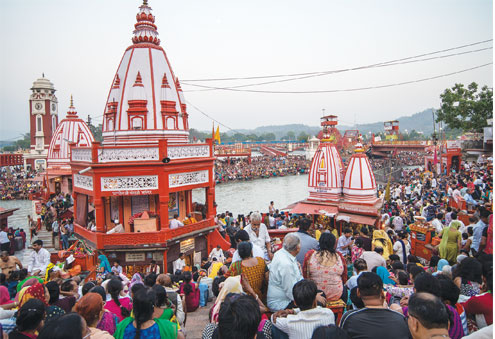
Our pujari-guide had to prompt us to hurry when we stopped to photograph a man with a painted face ringing a bell. It turned out he was advertising the merits of the Chotiwalla restaurant. It was only when we reached the aarti venue did we finally appreciate our escort’s concern: it was to ensure that we got to a strategic spot from which we would get a clear view of the ceremony. The ghats on both sides of the river were already packed to overflowing, and yet there was space for the tributaries of pilgrims pouring in.
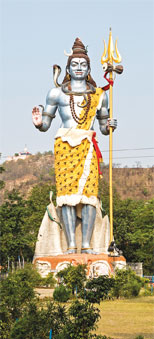
Har ki Pauri and the Maha Kumbh Mela
Indeed, Har ki Pauri is the stage for one of Hinduism’s greatest festivals: the Maha Kumbh Mela. This epic event which sees the world’s largest congregation of people at a single venue, occurs once every 12 years. (The next Kumbh Mela is slated to take place in Haridwar in the year 2022.)
The origin of the Kumbh Mela goes back to Vedic times when the devas (gods) and the asuras (demons) were locked in perpetual conflict. Separately, they attempted to retrieve the kumbh (pot) of immortal nectar from the deep oceans, but their efforts were foiled by the sheer magnitude of the task. In their desperation to get their hands on this prize, they set aside their eternal differences and decided to work together towards a common goal. Using Mount Parvat as a churning rod, they convinced Vasuki, the king of serpents, to be the churning rope. With the devas lined up along the tail of the giant snake and the asuras on the other side, they started to churn the ocean.
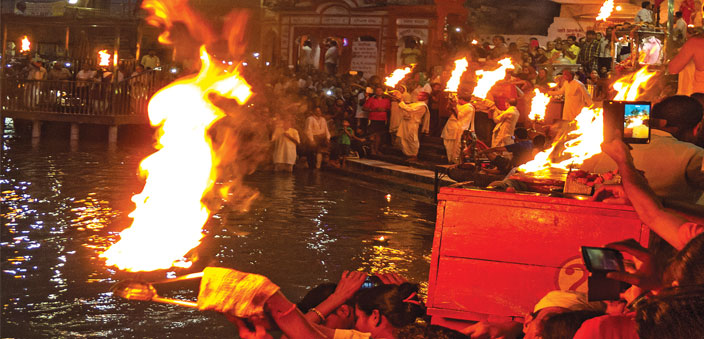
Finally, the ocean relented and the celestial physician Dhanvantari emerged from its depths, holding a pot brimming with the nectar of immortality. The fragile truce that had held the warring parties together fractured, and a great fight broke between the two sides, each one trying to wrest the pitcher for themselves. In the ensuing battle, the devas managed to get hold of the prize and were given chase by the asuras across the sky. In the process, a few drops of the immortal elixir fell at four different places in India: Prayag (Allahabad), Nasik, Ujjain and Haridwar. Ever since, this festival is held once every three years in rotation between the four cities.
The holy aarti
Meanwhile, the tolling of temple bells sent a thrill of anticipation through the crowd that had gathered at Har ki Pauri. A row of pujaris in white dhotis descended down the ghats to the edge of the waterfront. People were urged over the public announcement system to get out of the water as the aarti was about to commence.
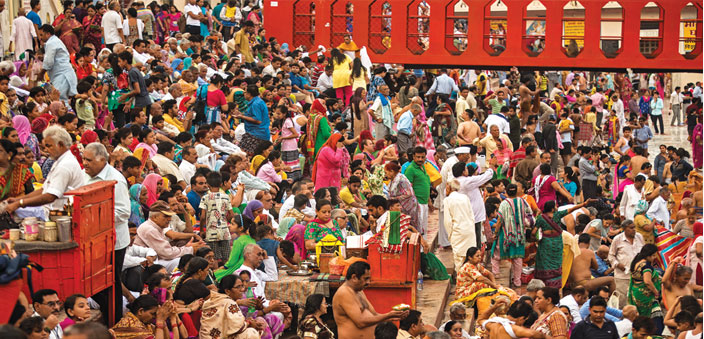
Yes, the Ganga aarti – a ballet of fire – was a spontaneous happening, sustained by the flames of pure, untainted devotion. Indeed, it captured the essence of Haridwar – raw and brilliant like an uncut diamond.
Fact File
Dehradun’s Jolly Grant airport is the closest airstrip to Haridwar (38 km).
Haridwar is connected by rail and road to Rishikesh (23 km) and Dehradun (52 km) to the north, and Delhi (171 km) to the south. The Shatabdi, in addition to other trains, runs between Haridwar and Delhi.
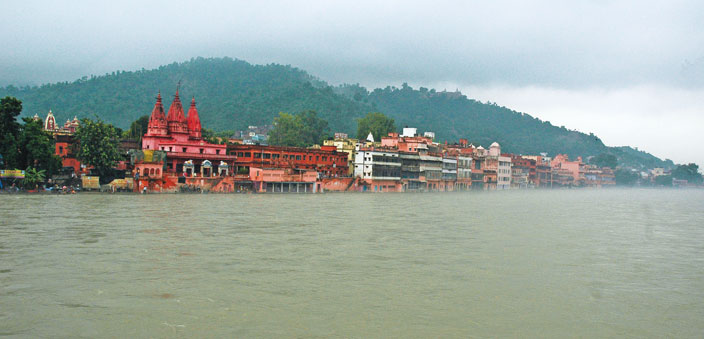
Haridwar and the neighbouring city of Rishikesh are the launching and terminating pads for the Char Dham pilgrim circuit of Badrinath, Kedarnath, Gangotri and Yamunotri.
One may use Haridwar as a base to go on a safari drive through neighbouring Rajaji National Park or maybe even spend a night there in the Garhwal Mandal Vikas Nigam lodge or The Forrest, a luxury tented camp located on the fringe of the park.
The hill station of Mussoorie is 84 km from Haridwar. One can also go river rafting with adventure sports tour operators located in Rishikesh. Or check into the award winning spa resort, Ananda in the Himalayas (42 km) (www.anandaspa.com)
For more information, visit Garhwal Mandal Vikas Nigam, an arm of Uttarakhand Tourism at https://gmvn.gov.in or Leisure Hotels at www.leisurehotels.co.in which has a number of heritage hotels in and around Haridwar, including luxury tented camps on the Char Dham circuit.


 [/column]
[/column]